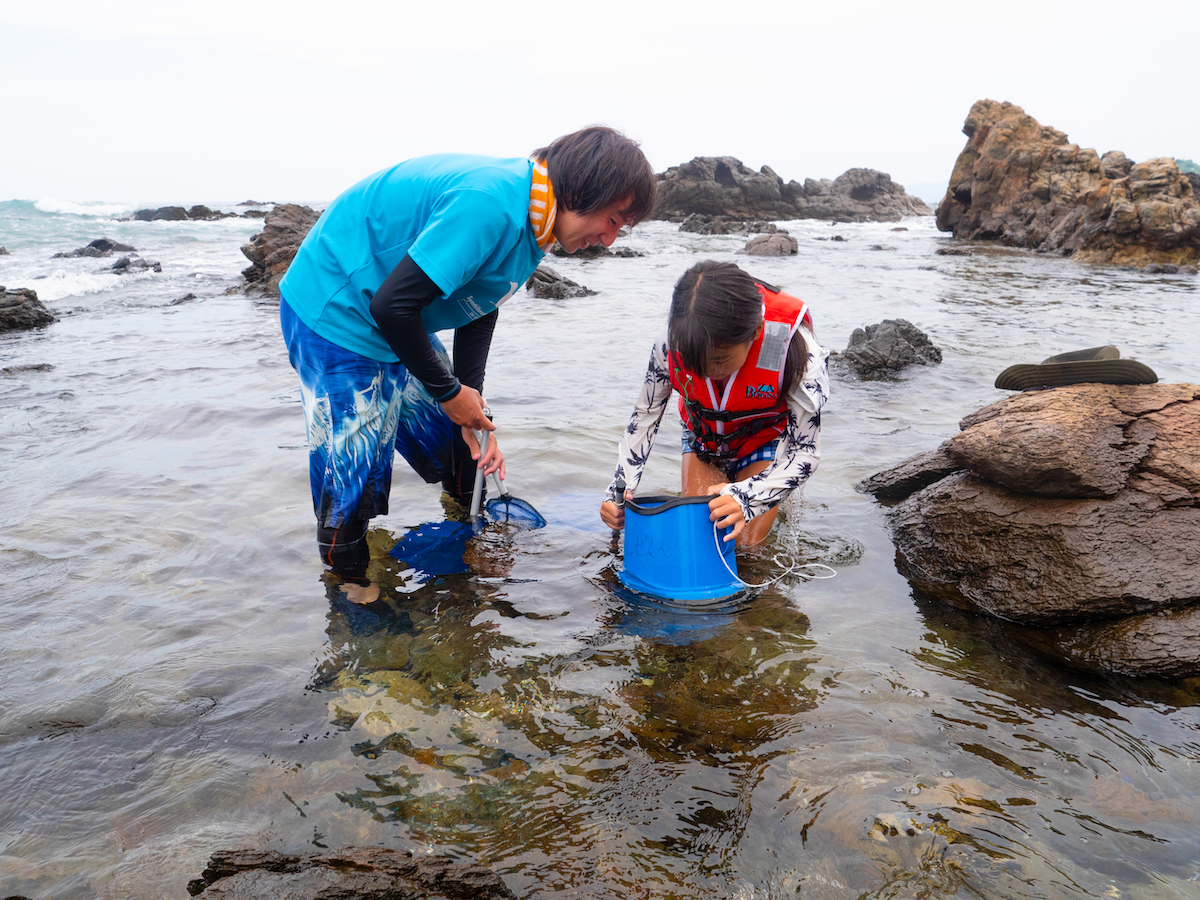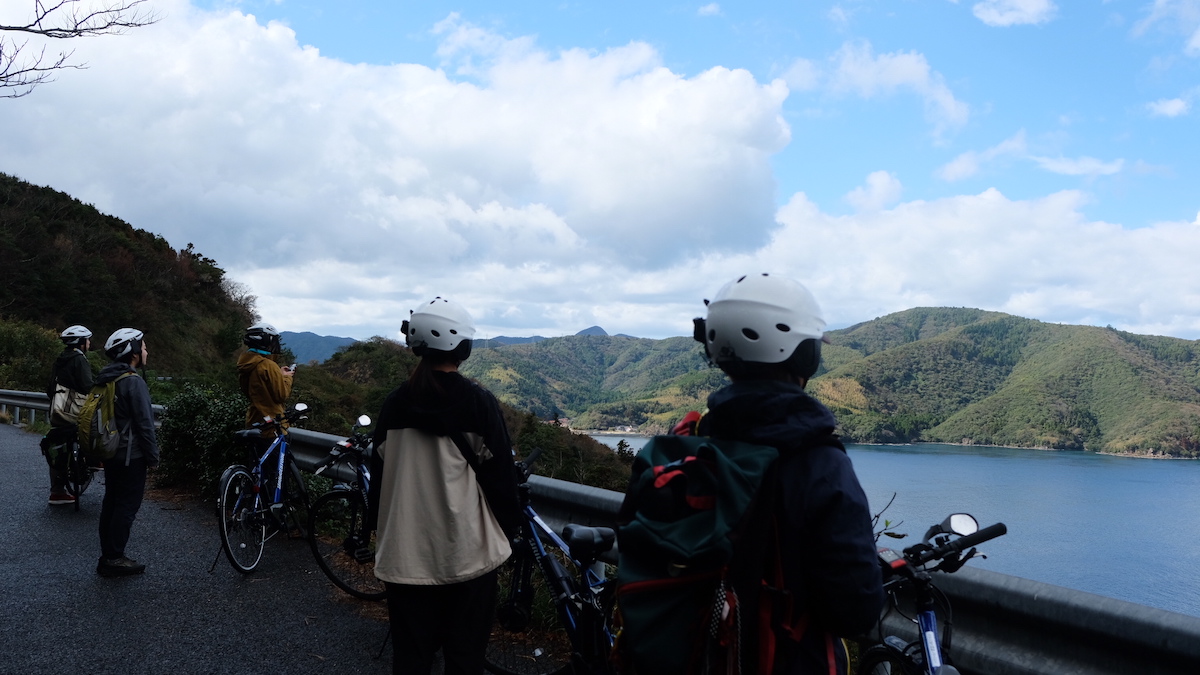Meet the Tour Guide: Taka
Takayuki Fukuda is a staff member of NPO Oki Shizen Mura in Ama Town. He is in charge of a wide range of activities, including eco-tour guiding, nature experience classes for local children, environmental education, and wildlife and plant surveys.
Ama Town is known for having many residents who have moved to live here from other regions of Japan. Taka is one of them, and in 2023 it will be nine years since he moved here. Originally he is from Fukuoka Prefecture (Kyushu Island in southern Japan).
From an early age, he was interested in animals and insects and liked to read picture books about them. He liked these things so much that he chose to study abroad at the University of Tasmania in Australia, where he studied animals and plants with a focus on environmental studies. After returning to Japan, he searched for a job related to nature and ended up in Ama Town, Nakanoshima Island in the Oki Islands.

“The moment I got off the ferry, I immediately felt like, this island is a place where I can stay.”
Taka recalls the first time he visited Ama Town. Tasmania, where he devoted himself to his favorite field of study, was also an island, so he felt nostalgic. At the same time, he was deeply moved by the rich nature of the island and the beauty of the sea, as well as the diversity of flora and fauna.
“I spent my childhood in a developed residential area, so I had almost no contact with living creatures. If you just go to the beach around here, you’ll find all sorts of fish, shellfish, and crabs. Since I’ve worked at Oki Shizen Mura, I’ve been doing research, surveys, and nature observation classes for school children, all as my job, and I can’t help but enjoy it!”

When he starts talking, his voice is full of joy, and curiosity fills his eyes and expression. You can feel that Taka truly loves nature and living things. His motto as a guide is, “Share what you find interesting.” He believes in sharing impressions and knowledge he has gained through his own experience, not just the theories from a book.

Oki Shizen Mura guided tours vary depending on the season and the needs of the visitors. There are various activities such as hiking, packrafting, and birdwatching. E-bike (electric sports bicycle) tours are easy to enjoy even for outdoor beginners. With Fukuda, we traveled the island on an e-bike, and we could listen to his commentary through the intercom attached to the helmet.

“Since it’s a bicycle, the point is that if something is interesting along the route, you can quickly stop. You can see the creatures, plants, and sights up close and explain them.”
Spending time together with Taka discovering the island’s unique “interesting things” that are often overlooked when traveling by car is an intellectual adventure that will stimulate your curiosity.

“When I find an endemic species along the road, I can’t help but become excited… I talk too much and almost forget to keep the time of the tour.”
Taka laughs, looking a little embarrassed. My commentary on insects tends to get very long, he says.
“For example, there is a beetle called ‘aohanamuguri’ (Cetonia roelofsi). It is green in many areas around Japan, but the subspecies found on the Dōzen Islands of the Oki Islands is dark blue. I was the only one who got very excited during that tour. The picture printed on my business card is a picture of the specimen I found at that time.”

As a visitor, I feel that his passionate side is the charm of traveling with Taka. When he explains about insects, he raises his bright voice by one tone, speaks a little faster, and his eyes sparkle. I was drawn in by the way the love for living creatures gushed out from his story, and it made me want to listen to him as much as possible.

Another advantage of e-bike tours is that you can feel the nature and scenery of Ama Town around you. For example, take the route from Hishiura Port to Akiya Coast. You can enjoy the view of Suwa Bay in the north of the island and feel the gentle breeze caressing your cheeks as you ride a bicycle.
“On the way, there is a wide plain surrounding the road.” At first glance, it looks like a normal rural landscape, but Ama Town is the only place in the Oki Islands that has such a large plain. Taka says that this is one of the “interesting” aspects of the island.

“The plain of Ama Town used to be a bay. A volcano erupted on the east side of the island, and lava flowed and filled the bay, turning it into flat land with gentle slopes. From an e-bike, you can notice those subtle changes in the scenery and topography.
“The creation of a plain here made rice cultivation possible, which gave the island food security, and allowed people who live here to prosper. I heard that people who were exiled here would do farm work together with the islanders. It is one of the ‘interesting’ experiences of this island to be able to feel the connection between the history, the nature, and the lifestyles of the local people, so I hope you will enjoy it during your stay.”
Even sightseeing spots that appear in guidebooks will look completely different when you visit them with Taka. Akiya Coast is one of them. It is a popular scenic spot for couples because of the towering giant rock called Bishago-iwa Rock, with a characteristic heart-shaped hole in it.

“It’s a place where you can’t just say, ‘It’s nice because there is a heart-shaped hole.’ There is another story here that I want the visitors to know.”
As he speaks, the expression on his face becomes like that of a child showing their treasured possessions.
When we walked along the coast together, Taka suddenly picked up a black rock lying on the ground.

“This is basalt. It is often seen in the geology of Dōzen, and it proves that the landscape here was created by a single eruption. Even though we are only 10 km apart from Dōgo Island, which you can see on the horizon there, the origins of the islands are different, as Dōgo was created through multiple eruptions.”
On the walking trail leading to Bishago-iwa, he points to the plants growing between the rocks.
“The plant that grows in high places here is darumagiku aster (Aster spathulifolius). It is a continental plant that grows in warm temperate climates. Close by there is also hamabiwa (Litsea japonica), which usually can be seen in warm areas. The reason why it thrives here is that it is warm even in winter thanks to the warm Tsushima sea current. However, you can hardly see hamabiwa on Dōgo. Even though it is so close, the climate is different due to the influence of the sea current. The Oki Islands are a mysterious place where you can see plants from various environments in one place.”

Hamabiwa usually grows in temperate regions

As we walked, every few steps I would be asked, “What do you think this is?” Topics expanded to include vegetation, topography, climate, ocean currents, island life, mythology, and cultural connections among the Oki Islands. It’s all about the stories you won’t find on information boards or in tourist brochures. Some of them are old stories and folk tales that he heard from his elderly neighbours at the local bar.
“Everything I see and hear in my daily life is a story I can use during guiding,” he laughs, but perhaps it is precisely because of his affection for the people of the island and curiosity about their daily life that he has such a breadth of knowledge.

Guiding for him is not about only one-sided explanations, it is to present the visitor with riddles and questions that will lead to a conversation. I felt my curiosity stimulated by this style of guiding, and I, too, began to become curious about everything I saw around me.
The knowledge gained from talking with Taka makes me feel like new horizons are gradually opening up in front of me. Before I knew it, beyond the scenery of Akiya Coast, I was looking at the ancient Earth and distant continents. Walking with Taka, even a rock or a small flower becomes a magical item that transcends time and space.

The Oki Islands, including Ama Town, have a mix of plants from cold and warm climates. Plants that usually inhabit either lowlands or highlands on Japan’s main island Honshu live together in the same area here in the Oki Islands. It is all closely related to the geohistory of this area, such as the formation of the landscape. It’s a place filled with features that Taka calls “interesting.”
“I want to convey the connections between nature, land, and people’s lives.”
I hear that many people ask Taka to be their guide every time they visit the Oki Islands, or they hear about him through word of mouth and ask for him specifically to be their guide. I couldn’t visit many spots during the interview, but I felt that no matter how much time I would have, it would still not feel like enough. No wonder there are repeat customers.
“Visitors often tell me that they can see how much I like the Oki Islands. I think that here, I can live as a part of the nature of the island. I feel a strong need to convey the things and knowledge I gained through living here.”

Wherever you go on the Oki Islands, you will see beautiful scenery. And if you know the stories behind those places, you will feel enriched with that knowledge and enjoy this place even more. I would like you to experience the magic of Fukuda, who will show you the other side of the “interesting” features that are not in any guidebook.
Taka's Favourite Location: Mt. Kinko-ji

On Mt. Kinko-ji where NPO Oki Shizen Mura is located, you can see plants from both cold and warm regions growing in the same place. There is also a natural spring gushing from the top of the mountain; this is an interesting topographical feature because such a spring would more often be found flowing from the middle of a mountain.
Both these features are related to the origins of the land. It is a very exciting place where you can discover the wonders of the Oki Islands both in terms of ecosystem and as a geopark. From the lookout point halfway up, you can see the flatland dotted with farming villages, all the way in the direction of Akiya Coast, and fishing villages in the opposite direction of the Toyoda area.
It’s a good spot to get a panoramic view of these areas, which have developed in different styles influenced by their topography. I like the scenery of rice fields, so I also like the lookout point at the foot of the mountain from where you can see the countryside part of the island.

